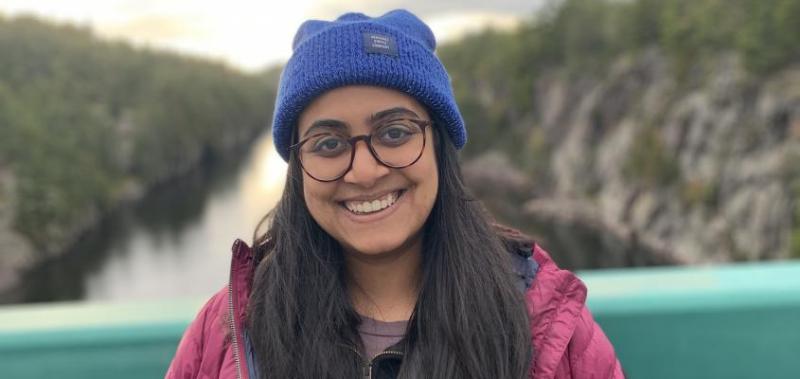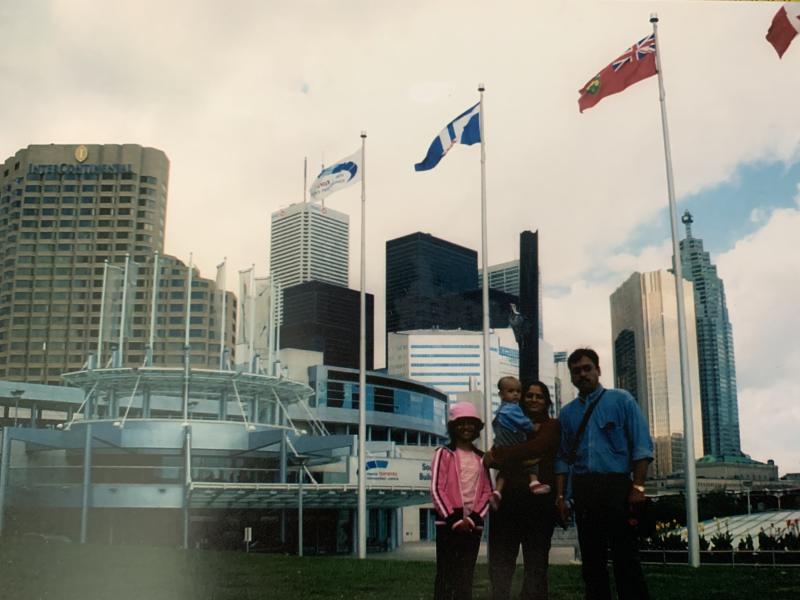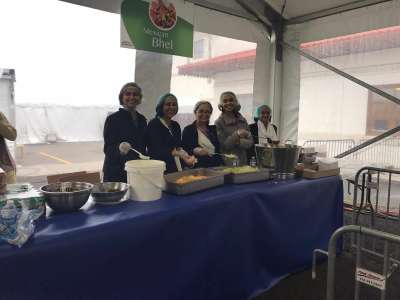August 18, 2022 | Alumni
Learning skills with different hands: Aarohi Pathak's research could help people with stroke
By Jelena Damjanovic

All photos courtesy of Aarohi Pathak
Aarohi Pathak (BKin 2017, MSc 2020, MScOT 2021) is a University of Toronto alum and a PhD student at U of T's Faculty of Kinesiology and Physical Education (KPE), where she researches how athletes learn - and the implications for helping people recover from stroke. Getting here has been a learning curve in itself.
Pathak moved from India to Canada with her family when she was nine years old. The transition was not without challenges.
“I came from a big joint family and all of sudden I found myself at home alone, taking care of my baby brother while my dad went to morning shift and mom to night shift at a factory nearby,” says Pathak. “We experienced a lot of financial hardship, so all the activities I used to enjoy in India such as dancing, karate, painting and swimming had to stop because my family couldn’t afford to pay for classes,” she says.

Another challenge was the language. Pathak didn’t speak any English prior to coming to Canada and found it difficult to follow the classwork and make friends in school.
Things started to turn around after Pathak enrolled in English as a second language (ESL) classes in her school. She started making friends and was speaking English in no time. She also learned about many free afterschool programs in the community and joined the soccer and tennis club over the summer.
“Being involved in sports and extracurricular activities helped me enjoy being in Canada and not think about back home so much,” she says.
Discovering you can study both sport and science: kinesiology
On top of sport, Pathak discovered a love of science, so when her high school gym teacher shared that he would be teaching a course called exercise science, she was intrigued.
“I remember asking him what I could study with a course like exercise science and that’s when I learned about kinesiology,” she says. “I enrolled in KPE that fall and when family friends would ask my parents what their daughter had chosen to study at university, they had trouble pronouncing and explaining kinesiology, so they would just say I was going to become a doctor (laughs).”

Pathak had been working part-time before starting university in order to contribute financially at home. She worried about how she would be able to balance working with studying without it affecting her grades.
“KPE provided me with multiple opportunities to work alongside my studies,” she says. “For example, during my entire undergrad, I worked as a KPE ambassador, hosting events for incoming students and representing KPE at various university fairs. This helped me to develop skills in project management, teamwork and communication.”
During her senior years, she made use of KPE’s in-field learning program, getting placements in leading hospitals and industries, expanding her network and getting summer jobs. Along with the financial support received from the faculty, she was able to successfully complete her undergraduate degree, while supporting her family.
Understanding how we learn physical skills could help people recover from stroke
The opportunities and support continued throughout her master's degree at KPE.
“The KPE faculty have always gone the extra mile to make sure students walk away from class with strong knowledge of the multidisciplinary ways in which kinesiology impacts society and individuals,” she says. “Associate Professor Doug Richards made sports medicine easy to understand by using chalk to draw on his clothes to help us visualize how the muscles and joints interact, Professor Michael Atkinson brought in real examples from sports media and current affairs about how psychosocial aspects govern how we live our lives. Professor Timothy Welsh and Associate Professor Luc Tremblay let me visit their labs during my undergrad and work on projects, which led me to pursue my masters and now my PhD at KPE.”
As a South Asian immigrant and a woman of colour, Pathak says she didn’t always find it easy to be assertive in a group and is grateful to the KPE faculty for being “so open, understanding and inclusive.” After completing her occupational therapy degree at U of T, she returned to KPE to pursue her PhD with Professor Welsh.
A Mitacs Globalink Research Award and an international grant from KPE made it possible for her to collaborate with a university professor in India, looking into an area of cognitive science that explores how the brain learns and stores memories of two learned skills that are similar but have components that oppose each other.
Results from my PhD work can help to better design rehabilitation protocols
“We are trying to understand the neural basis behind learning skills that are opposite in nature, and how we learn and retain these skills without negatively impacting performance,” she says. “To our surprise, our results so far have shown that learning two tasks which are contrasting leads to interference, meaning that we can’t retain both tasks at the same time when they are learned implicitly, without using any cognitive strategies. But, if we learn those two same tasks using cognitive strategies then both can be learned and retained simultaneously.”
Her research has also revealed that neural mechanisms for learning new skills are different across the two hands - and that retention and memory consolidation may be different when a task is learned through one arm as compared to when learned using both arms in sequence. The findings can have implications on how coaches and trainers support athletes during training.“In the longer-term, results from my PhD work on learning and transfer of skills can have implications on individuals with stroke affecting one side of the body and can help to better design motor skill training and rehabilitation protocols, including virtual reality environments-based training protocols,” says Pathak, who was recently awarded the Natural Sciences and Engineering Research Council of Canada (NSERC) doctoral award for her scholarly research.
A role model for breaking down racial, cultural and traditional barriers

When not working on her research, Pathak volunteers a lot of her time at the BAPS Swaminarayan Temple, teaching Gujarati to the young girls who attend.
“I’ve kind of turned into a role model for them,” she says. “Often, they talk to me about the lack of representation in their schools, which makes them sometimes question how they will be able to achieve their dreams. When they learn that I am pursuing a PhD, it gives them all more courage to break down racial, cultural and traditional barriers and move forward.”
Originally published by the Faculty of Kinesiology & Physical Edication

